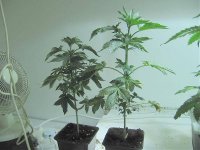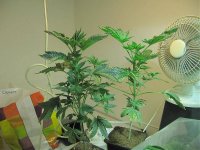From what you wrote, I assume you suspect that the UVA may have caused the damage to the exposed side of the bud. Another poster suggested that outdoor plants get plenty of UVA. This is true, natural sunlight has a ton of UVA and rolls off the UVB hard at around 300nm. The reptiglo bilb you used (26w CFL) uses aggressive UVB phospohors that do not emulate natural sunlight. Since you beamed that into the bud it is not surprising that there was tissue damage.
There are many other reptile lamps that do not use the aggressive phosphors. The repti glo tubes for example use the correct (human tanning) phosphors that roll off at 300nm just like sunlight.
I once read somewhere that back in the ol days (lol) suntan lotion was released that only blocked UVB but allowed UVA through. This caused some serious problems for tanners. Since the UVB was blocked, their skin could not develop the correct melanin and the UVA was allowed to penetrate the skin and go on the rampage (causing free radicals, tissue damage, even cancer).
Moral of the story is, when in doubt emulate the sun as naturally as possible. That's my 2 cents anyway, good luck!
Mean-As-Hell Australian sun:

Good info mate, I know they put carrots in a lot of suncreams, reason being carrot are high in carotenoids and the 6 carotenoids are a type of terpenoid and also found in cannabis and human eyes and skin.
I think UVA is useful in stimulating production of carotenoids, terpenoids and flavonoids, but too much is harmful to the plant, as we saw when I blasted that Oaxacan. I had the bulb too close imho as the other tops on the plant not so close to the bulb also showed the purple colouration indicating some change in the carotenoids etc but didn't have the same damaged trichomes I saw on the top nearest the bulb.
I now think reptile bulbs and tubes are a waste of time for UVB, they have so little. The intensity of UVB 15cm from a Reptiglo 5.0 tube was measured at only 15mw/cm2 whereas the same meter read 250mw/cm2 at 15cm from a Philips TL/12 20W tube.
By my calculations, the TL/12 is producing nearly 17 times the intensity of UVB without the UVA, violet, blue, green etc that the reptile tubes also produce.
This makes them a far more suitable source of UVB imho. UVA sources are cheap and readily available in the form of tanning or blacklight lamps/tubes.
I have researched the UVB intensities we need to emulate sunlight and found these figures that i am going to use as my guideline:
140mw/cm2 - UVB at sea level in California
250mw/cm2 - UVB at sea level at equator
375mw/cm2 - UVB at high altitude such as Himalayas, Kilimanjaro etc
So I am taking 140 as my minimum intensity needed and 375 as the maximum, however, in the distant past UVB levels were much higher so the higher order plant species (which includes cannabis) evolved in a high UVB environment and it has been shown that cannabis can be grown under extremely high UVB levels, demonstrating it's ability to adopt to intense UVB. Therefore there theoretically is no upper limit, but if we are trying to emulate nature today, then 375 is the highest you can get on the earth's surface unless you are stood in the Antarctic under the whole in the ozone layer.
I am aiming for an intensity of at least 250mw/cm2 of UVB as I am growing equatorial sativas and want to emulate their natural environment. This just isn't possible with reptile tubes and all the other UVB sources apart from the TL/12 have way more UVA than UVB so in order to reach the 250 figure with a lamp other than the TL/12 would mean you also had very high levels of UVA and I think that would be detrimental to the plants.
So unless someone knows of another pure UVB source, the TL/12 tube is the only option, it is a pure UVB source as it has no UVA or visible light.
Further reading last night tells me that all of the UVB spectrum from 280 to 320 is significant in THC production. 300 to 320 affects THC production directly and 280-300 affects the production of THC precursors. Therefore the TL/12 with it's broadband UVB spectrum centred on 311nm is the ideal lamp for stimulating THC production.
UVA doesn't have a role in THC production stimulation but is useful for stimulating production of other stuff.
Therefore my lighting system I'm building for my experiments is going to be using Actinic tubes for deep blue, violet and the higher part of the UVA spectrum; tanning tubes to cover all of the UVA spectrum with a tiny bit of the higher part of the UVB spectrum and TL/12 tubes for UVB.
I think what needs to be worked out is the ratios of UVB, UVA and blue needed. I've already explained the intensity level of UVB needed, but I'm not at all sure what intensity of UVA and blue are needed. Maybe the place to begin is emulating the UVA levels at the equator at noon as that is how I determined the UVB levels needed.










